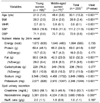1. He FJ, MacGregor GA. Reducing population salt intake worldwide: from evidence to implementation. Prog Cardiovasc Dis. 2010. 52:363–382.

2. Luft FC, Weinberger MH. Heterogeneous responses to changes in dietary salt intake: the salt-sensitivity paradigm. Am J Clin Nutr. 1997. 65:612S–617S.

3. Gong M, Hübner N. Brigelius-Flohe R, Joost HG, editors. Gene variants, nutritional parameters and hypertension. Nutritional Genomics: Impact on Health and Disease. 2006. Weinheim: Wiley-VCH Verlag GmbH & Co. KGaA;327–354.

4. Polonia J, Martins L. A comprehensive review on salt and health and current experience of worldwide salt reduction programmes. J Hum Hypertens. 2009. 23:771–772.

5. Mohan S, Campbell NR. Salt and high blood pressure. Clin Sci (Lond). 2009. 117:1–11.

6. Korea Centers for Disease Control and Prevention. National Health Statistics. Report for the Fourth Korean National Health and Nutrition Examination Survey (KNHANES IV). 2008. Cheongwon: Korea Centers for Disease Control and Prevention.
7. Kim KS, Paik HY. A comparative study on optimum gustation of salt and sodium intake in young and middle-aged Korean women. Korean J Nutr. 1992. 25:32–41.
8. Kim HM, Park J, Ryu SY, Kim J. The effect of menopause on the metabolic syndrome among Korean women: the Korean National Health and Nutrition Examination Survey, 2001. Diabetes Care. 2007. 30:701–706.
9. Lee SW, Cho HH, Kim MR, Kwon DJ, Kim EJ, You YO, Kim JH. The relationship between serum leptin level and metabolic syndrome in postmenopausal women. Korean J Obstet Gynecol. 2010. 53:254–263.

10. Lee JY. A study of salt consumption and related factors among adult females. Korean J Food Nutr. 2001. 14:430–440.
11. Kim HJ, Paik HY, Lee SY, Shim JE, Kim YS. Salt usage behaviors are related to urinary sodium excretion in normotensive Korean adults. Asia Pac J Clin Nutr. 2007. 16:122–128.
12. Murphy SP, Kaiser LL, Townsend MS, Allen LH. Evaluation of validity of items for a food behavior checklist. J Am Diet Assoc. 2001. 101:751–761.

13. Howitz W. Official Methods of Analysis of AOAC INTERNATIONAL. Chapter 4. 2000. Gaithersburg: AOAC international.
14. Kim JA, Chaung SK. Weight control and cardiovascular risk in middle-aged women. Korean J Rehabil Nurs. 2004. 7:33–47.
15. Kim HS, Oh JA. Comparison of the metabolic syndrome risk factor prevalence forty and fifty something women. J Korean Acad Nurs. 2007. 37:453–458.

16. Moon HK, Kim EG. Comparing validity of using body mass index, waist to hip ratio, and waist circumference to cardiovascular risk factors of middle aged Koreans. J Korean Diet Assoc. 2005. 11:365–374.
17. Shim YJ, Paik HY. Reanalysis of 2007 Korean National Health and Nutrition Examination Survey (2007 KNHANES) results by CAN-Pro 3.0 nutrient database. Korean J Nutr. 2009. 42:577–595.

18. Moon HK, Park JH. Comparative analysis and evaluation of dietary intake between with and without hypertension using 2001 Korea National Health and Nutrition Examination Survey (KNHANES). Korean J Nutr. 2007. 40:347–361.
19. Kim JY, Kang YR, Lee MY, Paik HY. Sodium intake and preference for salty taste in elementary school children residing in rural and urban areas of Korea. Korean J Nutr. 1990. 23:248–256.
20. Ahn EJ, Noh HY, Chung J, Paik HY. The effect of zinc status on salty taste acuity, salty taste preference, sodium intake and blood pressure in Korean young adults. Korean J Nutr. 2010. 43:132–140.

21. Oh KW, Yun EJ, Oh ES, Im JA, Lee WY, Baek KH, Kang MI, Park CY, Choi MK, Yoo HJ, Park SW. The relationship between urinary sodium excretion and bone mineral metabolism of climacteric women in Korea. Korean J Med. 2003. 65:436–442.
22. Kim MK, Yun YM, Kim Y. Developing dish-based food frequency questionnaire for the epidemiology study of hypertension among Korean. Korean J Community Nutr. 2008. 13:701–712.
23. Son SM, Huh GY, Lee HS. Development and evaluation of validity of dish frequency questionnaire (DFQ) and Short DFQ using Na index for estimation of habitual sodium intake. Korean J Community Nutr. 2005. 10:677–692.
24. Son SM, Park YS, Lim WJ, Kim SB, Jeong YS. Development and evaluation of validity of short dish frequency questionnaire (DFQ) for estimation of habitual sodium intake for Korean adults. Korean J Community Nutr. 2007. 12:838–853.
25. Park YS, Son SM, Lim WJ, Kim SB, Chung YS. Comparison of dietary behaviors related to sodium intake by gender and age. Korean J Community Nutr. 2008. 13:1–12.
26. Yim KS. The effects of a nutrition education program for hypertensive female elderly at the public health center. Korean J Community Nutr. 2008. 13:640–652.
27. Ryu HS. A study on the dietary habits of people in Gyeonggi area by age groups - based on the nutrition counseling data of medical health examination -. Korean J Food Nutr. 2006. 19:410–415.






 PDF
PDF ePub
ePub Citation
Citation Print
Print



 XML Download
XML Download